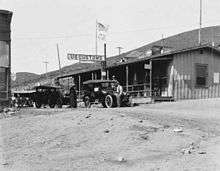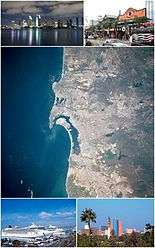San Ysidro Port of Entry
| San Ysidro Port of Entry | |
|---|---|
|
San Ysidro Border Inspection Station 2011 | |
| Location | |
| Country | United States |
| Location |
720 East San Ysidro Blvd. San Diego, CA 92173 |
| Coordinates | 32°32′36″N 117°01′47″W / 32.54333°N 117.02972°WCoordinates: 32°32′36″N 117°01′47″W / 32.54333°N 117.02972°W |
| Details | |
| Opened | 1906 |
| Phone | (619) 690-8800 |
| Hours | Open 24 Hours |
| Exit Port | El Chaparral |
| Statistics | |
| 2015 Cars[1] | 14,435,252 |
| 2015 Trucks[1] | 0 |
| 2015 Pedestrians[1] | 7,056,022 |
The San Ysidro Port of Entry is the largest land border crossing between San Diego and Tijuana. It connects Mexican Federal Highway 1 with Interstate 5 on the U.S. side. The San Ysidro Port of Entry is one of three ports of entry in the San Diego–Tijuana metropolitan region.
History
There has been a land border inspection station in the community of San Ysidro since the early 20th century.

Since its beginning, cars, pedestrians and trains were inspected here.
In 1933 the NRHP-listed Old Customs House was built in Mission Revival style, and still stands housing offices. Trucks also once crossed at this location, but in the 1950s, due to congestion, all truck traffic was moved a short distance west to a crossing at Virginia Avenue. Then in 1983, the Otay Mesa Port of Entry was opened and all truck traffic is now inspected there.
The current San Ysidro Land Port of Entry facility was constructed in the 1970s to meet the needs of the time and the projected growth in the coming years. Nearly forty years later, this port of entry has reached its adequate operational capacity and after eight years of planning, it is ready for a major facelift.
With over 90,000 daily commuters crossing between Tijuana and San Diego, commuting has become a challenge for everyday commuters in the metropolitan region; visitors to and from Baja California spend one to three, and as many as five, hours waiting to enter into the United States. U.S. Border and Customs officials have said that newly implemented inspection technology and properly processing the large number of persons and vehicles who go through the port on a daily basis have resulted in long lines and long wait times.[2]
San Ysidro Land Port of Entry Expansion Project
| Proposed San Ysidro Port Facility | |
|---|---|
|
Aerial view of artist's rendering of the finished San Ysidro Land Port of Entry in 2015. | |
| General information | |
| Status | Under expansion |
| Type | Administrative, Immigration and Customs Inspection |
| Location | San Diego, CA |
| Construction started | December 2009 |
| Estimated completion | September 2015 |
| Opening | Current facility will remain operational during expansion and construction phases. |
| Technical details | |
| Floor count | 4 |
| Floor area | 225,000 sq ft (20,903 m2) of office space, 110,000 sq ft (10,219 m2) of inspection operations space[3] |
| Design and construction | |
| Architect | Miller Hull Partnership |
| Developer | General Services Administration |
The San Ysidro Land Port of Entry Expansion Project is a bi-national effort between the United States and Mexican governments which aims for the demolition, relocation, expansion, renovation, modernization and construction of new administrative and operational facilities of the current land port of entry in the San Ysidro district of San Diego. The project calls for a complete overhaul of the current international border inspection facilities on both sides of the border at a total cost of about $625 million which includes $577 million[4] for the expansion of the northbound U.S. point of entry and roughly $48 million (MXN $598) for the construction of an entirely new southbound Mexican point of entry.[5]
The project is being carried out in three phases:[6]
- Phase I involves the expansion of northbound vehicle lanes, the implementation of dual primary vehicle inspection booths and a higher capacity secondary inspection facility.
- Phase II involves the demolition of the current administrative building and construction of bigger replacement along with a multi-story employee parking structure. A new pedestrian processing building will also be constructed.
- Phase III involves the relocation of the southbound lanes entering Mexico. These lanes will be moved west of their current location to make space for the planned expansion of new buildings, parking structure and extra northbound lanes. Their new location will allow for a southbound traffic checkpoint to facilitate U.S. officials to conduct inspection of vehicles heading to Mexico. Mexican officials will greet vehicles and occupants at a bigger and better equipped immigration and customs inspection station known as Puerta Mexico El Chaparral.
Construction
- 2011
- On the U.S. side, construction of the new east/west pedestrian bridge was completed on February 15, 2011.[7]
- On September 14, 2011, part of the wooden panels and support beams from the construction project collapsed on vehicles crossing the border, injuring nine people, two seriously. All northbound traffic was diverted to the Otay Mesa Port of Entry for the rest of the day, causing massive traffic jams.[8]
- 2013
- On the Tijuana side construction of links to connect the new El Chaparral Facility with Via Rápida and Avenida Internacional, which leads drivers to the western Tijuana borough of Playas de Tijuana and nearby Rosarito Beach, was built in 2013 (see below).[9]
- 2015
Prior to September 2012, pedestrians walked from the U.S. to Mexico by crossing a pedestrian bridge, entering Mexico to the west of Interstate 5, and walking through a corridor leading to the west side of the crossing (Avenida de la Amistad). Then a temporary pedestrian crossing facility was built on the Mexican side on the east side of the crossing. This was replaced when in August 2015 Mexico inaugurated a new pedestrian crossing facility to the east of the northbound traffic lanes. For the first time foreigners are required to show passports when entering Mexico at the border, whereas previously they only had to be shown when entering the interior of the country.[10][11]
- 2016
On July 15, 2016,[12] the PedWest pedestrian crossing and Virginia Avenue transit center were opened, at the east side of the Las Americas outlet mall where Virginia Avenue dead-ends at the border, adjacent to the El Chaparral port of entry into Mexico. On the Mexican side a temporary, partially enclosed walkway was opened connecting this crossing southeastward to the pedestrian bridge from Plaza Viva Tijuana that heads southwest to Downtown Tijuana.[13] This walkway was nicknamed "Puente Chicanadas" ("cheap/quick fix bridge") and characterized by some as dangerous, suffocating and embarrassing to Mexico. In September 2016, a definitive walkway from Plaza Viva Tijuana costing 25 million pesos (about 1.3 million dollars at the time), was opened.[14]
Gateways
El Chaparral Point of Entry
The southbound lanes of Interstate 5 which take vehicles into Mexico have been moved west of their previous location through the new El Chaparrel Point of Entry (Spanish: Puerta Mexico el Chaparral).[15]). This relocation and expansion was necessary to provide space for the construction of new administrative and border inspection facilities and to increase the number of northbound vehicle lanes. The El Chaparral gateway also has a vehicle and passenger inspection station at which U.S. officials may conduct inspections of southbound traffic, and provides for more thorough inspection of southbound traffic by Mexican officials.
See also
References
- 1 2 3 US Department of Transportation
- ↑ "Installation of New Technology Expected to Slow Border Crossings". KPBS. Retrieved April 18, 2011.The article states: "U.S. Customs and Border Protection officials are warning of delays this summer 2008 at California border crossings as they install new technology. They say the new tools will ultimately decrease wait times."
- ↑ Design Overview, (PDF) https://web.archive.org/web/20110104233112/http://www.gsa.gov/graphics/regions/san_ysidro_pr_aug2010.pdf. Archived from the original (PDF) on January 4, 2011. Retrieved November 9, 2010. Missing or empty
|title=(help) - ↑ Project Funding, http://www.gsa.gov/portal/content/103065
- ↑ In Spanish, El Chaparral Expansion Project, https://web.archive.org/web/20110716204401/http://www.bajacalifornia.gob.mx/portal/noticia_completa.jsp?noticia=19316. Archived from the original on July 16, 2011. Retrieved November 9, 2010. Missing or empty
|title=(help) - ↑ San Ysidro Construction Project, http://www.sdnn.com/sandiego/2010-01-25/mexico/san-ysidro-construction-project-expected-to-last-until-2015
- ↑ "New Footbridge Opens to Public". NCB San Diego. Retrieved 15 April 2011.
- ↑ Several injured in border crossing roof collapse, San Diego Union-Tribune, retrieved September 14, 2011
- ↑ Spanish, El Chaparral Expansion Project, http://www.bajacalifornia.gob.mx/portal/noticia_completa.jsp?noticia=19316
- ↑ "New pedestrian crossing unveiled in Tijuana", Sandra Dibble, San Diego Union-Tribune", Aug. 19, 2015
- ↑ "First day of new pedestrian border crossing", San Diego Red, September 24, 2012
- ↑ "Pedestrian Crossing At San Ysidro Opens", KPBS, July 15, 2016
- ↑ "Everything You Need to Know About PedWest, San Ysidro’s New Pedestrian Port of Entry", San Diego Red, July 2016
- ↑ "Adiós al puente chicanadas; ya funciona la obra definitiva en Ped West", Sintesis TV, September 12, 2016
- ↑ Project Overview, https://web.archive.org/web/20110503091028/http://www.gsa.gov/portal/category/21521. Archived from the original on May 3, 2011. Retrieved May 9, 2011. Missing or empty
|title=(help)
External links
| Wikimedia Commons has media related to San Ysidro Port of Entry. |
- U.S. GSA: Official San Ysidro Land Port of Entry website
- U.S. GSA: design renderings of new San Ysidro Port of Entry
- U.S. GSA: construction photos of new San Ysidro Port of Entry
- Signonsandiego.com: Plan of new San Ysidro Port of Entry

